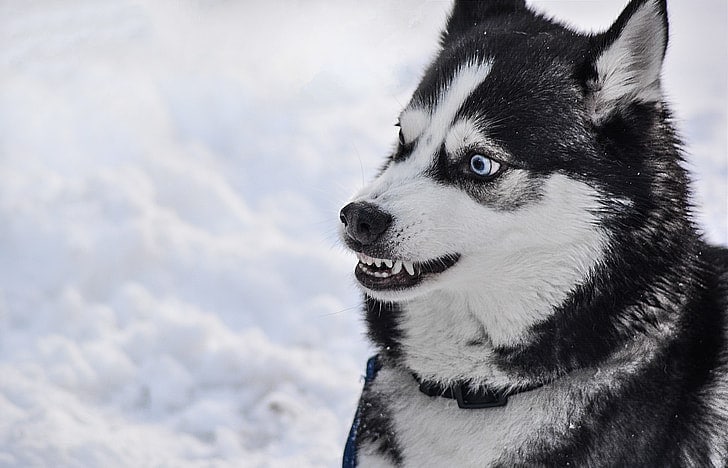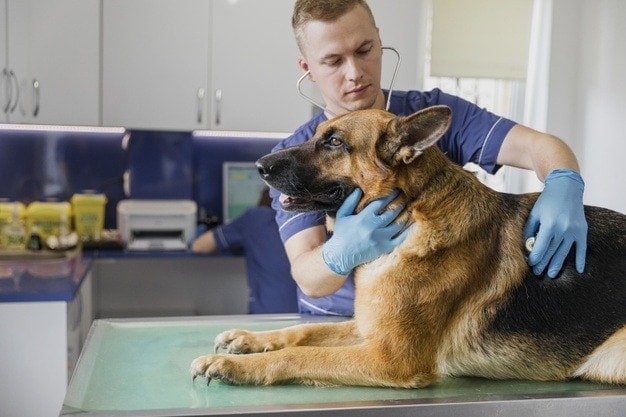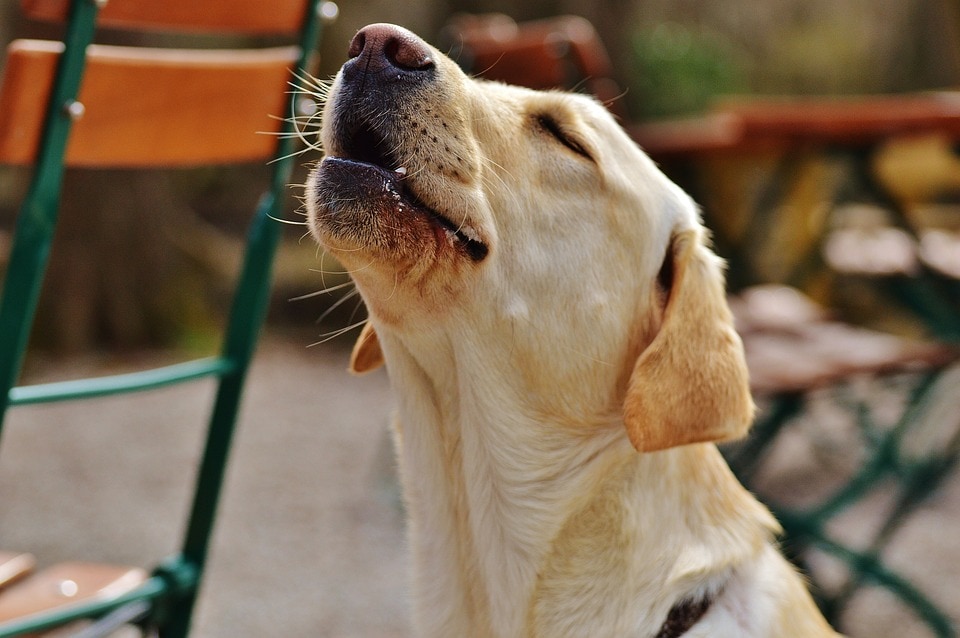8 Types of Dog Growls & What They Mean (With Audio)

Updated on

When you hear a dog growl, your natural reaction is probably to back up slowly and get away. And that’s because we associate a growl with aggressive behavior and a distinct warning sign to leave them alone.
After all, the last thing we want is to get bitten.
But not all growls actually mean that a dog is going to bite. In fact, there are a few other types of growls that can help you understand exactly what a dog is feeling and how to aid them if they’re in need.
But before we look into the many different types of growls, you need to understand what a growl actually is and how pitch and duration truly make a difference.
What is Growling and Why Do Dogs Growl?

As much as we wish they could, dogs cannot use their words to communicate with us. Instead, they use different sounds and body language to “talk” to us. A growl is one of these sounds.
Growls usually aren’t the most pleasant of canine noises. They distill fear in whoever hears them, and for good reason. Dogs normally don’t growl when they’re happy. Growls stem from discomfort and aggression. However, there are different types of growls in different situations.
You can distinguish different growls generally by their pitch and duration. A dog growling out of aggression is going to sound very different than one growling because of play.
Normally, dog growls that are lower-pitched with longer durations are the ones you need to be most concerned about. These are warning growls telling you to back off or stop whatever you’re doing. However, high pitched growls with short durations can be signs that your pup is ready to goof around with you!
But just because a dog’s growl sounds one way or another, that doesn’t mean you should throw caution to the wind. Be sure to watch their body language when they’re growling. This will give you deeper insight into what their growl means.
The 8 Types of Dog Growls
Now that we know why dogs growl, let’s take a closer look at some of the different types of growls you’ll hear.
1. Threatened and Fearful
While some dogs will quickly scamper away at the first sign of trouble, others will stand fast and hold their ground. And the first thing they’ll probably do is let out a growl.
When dogs feel threatened, that doesn’t necessarily mean they’re going to bite — but this is one of those times where they just might. If a dog feels threatened and growls at you, the best thing to do is just give them their space. If your dog is leashed and is growling at something (or someone) else, it’s best to remove your pup from the scene. It’s not always best to force your pooch to make friends.
By de-escalating the situation, the pup may feel more at ease and cease growling altogether. However, if the growling continues, it may be time for you to find somewhere else to be.
A fearful growl is often characterized by a low rumbling growl with a closed mouth. You’ll notice your pup exhibit stiff body language, and they may be holding their breath.
2. Angry and Aggressive
If you start hearing a dog giving out an aggressive, angry growl, you’ll know it immediately. It’s the type of growl that sends shivers down your spine. And that’s because this dog is ready to attack.
With fearful growling, the dog just wants to be out of the situation and have their space. However, when you start hearing aggressive growling, things can get dangerous quickly. This means they’re ready to close the distance and attack.
If you encounter a strange dog growling aggressively at you, find a safe space, and stay there until the dog has left or until proper control has been taken.
An aggressive growl can be a scary experience. You hear the dog let out long, low rumbles, but this time they’ll bare their teeth. Like the fearful growl, their body language may grow stiff, but they’ll often lunge as a show of power and dominance.
3. Anxious Growling
Have you ever seen your pup growling for what appears to be no good reason at all? This could be anxious growling. Anxious growling typically occurs when your pup isn’t accustomed to their environment, or they’re being triggered by some unexpected change.
Your pup may growl at a food bowl if you switch it up from wet food to kibble. Or maybe you go to a different dog park and the new sights, sounds, and smells begin to overwhelm them.
Some dogs are more prone to anxious growling than others, but this type of growling can be minimized. Through early socialization and training, your pup will grow more accustomed to environmental changes, new people, or strange situations.
Anxious growls come in shorter, lower-pitched bursts. Your pup may exhibit a more active behavior than other growls—even bordering on manic movements. These anxious growls can normally be sated through gentle, calming strokes and time allowing your pup to acclimate to the situation.
4. Frustration Growls
Frustration growls are very similar to anxiety growls; however, they’re much more directed to a certain person or situation. This normally happens when your dog’s desires or needs are not being met.
For instance, if you’ve been outside playing fetch for 30 minutes, there’s a good chance that your arm is going to start to get tired. And while you’re ready for a break, your beloved pooch might not be. They may growl in frustration that you aren’t throwing the ball when they’re ready for another round.
While frustration growling is non-aggressive, that doesn’t mean it isn’t an issue. And that’s because any other dog or person around them may misconstrue your pup’s meaning. Another could take it as an act of aggression and become defensive.
Frustration growls normally have a varied pitch and frequency to them. Your pup may even start to whine while growling. Their body language may become more active like with anxiety growling; however, it will be more directed at a particular situation and less manic.
5. Playful Growling
Out of all the types of growls, this is the one you might get excited hearing. And that’s because playful growling means your pup is probably having a great, happy time. Dogs—especially puppies—can play rough. They enjoy their version of tag, wrestling, tug-of-war, and other “aggressive” games.
But that doesn’t mean they’ll end up in a fight every time they play rough. If you hear your pup growling with another dog or person while playing, there’s normally nothing to worry about.
The main thing you need to watch during this time is their body language. Are they having fun and bouncing around happily? Are they exerting themselves and growl-grunting while playing tug-of-war? If so, no need to interfere. However, if the growls start turning aggressive, you might want to pull them aside for a quick break.
Growls while playing are normally very pitchy and breathy. This is because the dog is normally playing. Their body language will be relaxed and happy. You may notice them use the growls as signals as well. If your pup bends their front half down, sticks their rear in the air, and playfully growls at you, you’ve probably just been told to hurry up and chase them.
6. Pain Growls
Sickness and injury can be another reason why dogs growl. Just think about when you’re sick. You might not want a bunch of people bothering you, and dogs can be the same way. If they’re just a bit under the weather and don’t feel like snuggling, that’s fine. Leave them be and allow them to recover in peace.
However, it’s not just sickness. Your dog may have physically hurt themselves and be in pain. One of the most common signs of pain in dogs is growling. These growls are normally accompanied by yelping. Yelping is a high-pitched sound that can range from a small squeak to full baying.
There’s also a good chance that the intensity of the growling will increase if you touch them or get near the affected area. This isn’t because they don’t like you, but because they’re afraid that more harm will come. If you start noticing signs of pain in your pup, the best you can do is get them to a veterinarian clinic pronto.
7. Territorial or Possessive Growling
Some dogs just love the company and sharing the world with everyone around them. And other pups don’t share that sentiment at all. In fact, dogs by nature are very territorial creatures and will protect their turf at all costs.
If you begin to encroach on a territorial dog’s area, they won’t hesitate to let you know. This is often done through excited barking; however, a low growl can be used when they mean business. Often, the best way to ease their growling is to simply back away from the property. This should solve the issue quickly and with no additional stress. After all, they’re not after you. They’re just guarding their territory.
This same concept can also be applied to their family members, food, toys, or anything else they love. Lots of companion dogs tend to become obsessive over their owners. And when someone new approaches them, the pup may go into protective mode. Or your dog may start growling if they’re being bothered while eating. A good rule of thumb is to never bother a pooch while they’re eating or gnawing on their favorite chew.
8. Purring
And you thought purring was strictly reserved for cats! But when dogs are experiencing pleasure they don’t want to end, they can let out a growl that sounds very similar to a cat’s purr.
This is the best type of growling by far. It’s a long deep vibration that lets you know that they’ve truly found their happy place and they aren’t looking to leave it. Your dog’s body language will also mirror their feelings. They’ll be super relaxed and will let down their guard so you can love them more.
FAQ: Why Do Dogs Growl
While we’ve covered in-depth eight different types of dog growls, there are a few other things that you should know.
Growl vs Dog Snarling
What’s the difference between a growl and a snarl?
A growl can be scary, but they’ve got nothing on a snarl. If you see a dog snarling at you, you need to diffuse the situation immediately. Snarling is a dog’s way of letting you know to watch out because they’re going to attack.
Growls are warnings to inform you that something’s not right, and it should be fixed. Snarls are past the point of warning. You can tell that a dog’s snarling by listening to the growl they’re making. A snarl is often a loud and deep growl that may be pitchy.
The dog will also be exhibiting severely aggressive body language. They will bare their teeth, and you may notice that their hair is sticking up awkwardly. Check out their tail movement as well. Is it relaxed and flowy? Or stiff and rigid? If the dog’s tail movement is stiff or standing straight out, it’s another sign of aggression.

Neutering and Spaying
Does neutering or spaying your dog help eliminate growling?
While it does help to control the stray animal population, it does not stop a dog from growling.
It’s a common myth that spaying or neutering your pet will stop unwarranted aggression. In all reality, a dog will still growl as long as there’s an issue bothering them.
Punishing for Growling
Should you punish your dog for growling?
The worst thing you can do when a dog growls is to punish them. This can end very badly in a couple of ways. First, the dog acknowledges that you’ve ignored their cues and could go straight to biting without further warning next time.
Second, this could train your dog that no warning is required when things go awry. This is how many “dog-bit-me-for-no-reason” cases happen. Instead of punishing growling, the number one solution is to determine the stressor and eliminate it.
Final Thoughts: Dog Growling
Growling is a normal part of a dog’s life. They’ll do it when they’re happy, sad, angry, or confused. However, the real trick is knowing what kind of growl they’re exhibiting. Remember, a growl is their chief way of communicating problems to you. It isn’t anything that they should be punished for or trained not to do. By being aware of the different types of dog growls, you’ll be able to handle yourself around dogs much better.
Related Read:
Featured image credit: simonocampo999, Pixabay












